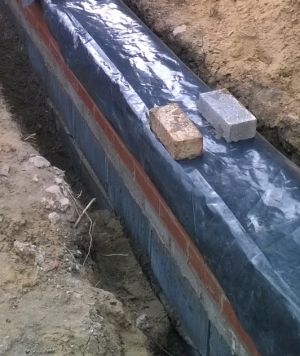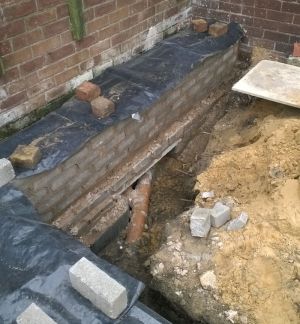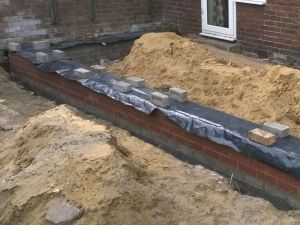Anatomy of a building
I never realised there were so many types of brick.
Building the extension has taught me a lot about what actually goes into a building, and where, and why. A lot of the things you learn are like answers to questions you’d never thought about. Like, where does a foundation begin and end? How deep is it, how much of it is concrete? What goes between two layers of walls?
So here’s a quick breakdown of interesting building things:
Concrete foundations
- The bottom of a foundation is cast concrete. It has to stand on an “approved substrate” which is something a Building Control Officer has to approve before the concrete is poured. In Southport, this is undisturbed yellow sand, a depth of 0.7m below ground for us.
- The concrete has to meet an approved ratio of depth and strength which is normally stipulated on the plans drawn by your plan drawer. We were required to pour a thickness of 150mm but went the extra and did 200mm. You don’t fill the whole trench depth! From this point upward you will use special bricks or blocks.
- The width of a wall must be at least 300mm total (outer wall, inner wall, and air gap). The width of the trench it stands in must be at least 600mm. This is because constructors assume load bearing occurs at a 45 degree angle, so the width of the concrete poured on either side of the wall must be matched by the depth of the concrete. (600-300)/2 is 150, so that’s also the minimum depth required.
Underground block and brick

Layers of block and brick in the trench, partly backfilled - view full size
- We got to see the foundations of our house during this work. There is a concrete foundation, and then about two courses of brick before the structure is above ground. Provided that the foundation meets the standards above, you can still do something like this - simply coming out of the ground with brickwork.
- However, due to the trench depth, we used large, light concrete blocks with a high compressive strength. This combination of attributes makes them pretty cool technology in my opinion. These are often referred to as “trench blocks” or even “Turbo blocks” (a brand name I think). They are brittle and powdery, almost like pumice, and can be sawed to size. Their load-bearing attributes are equal in all planes.
- We have two courses of trench blocks laid onto the concrete with a normal mortar.
- After these blocks, we have “concrete commons”. These are a heavy concrete brick with a “frog” (indentation) on the top. They can be resized with a hammer and bolser. These are laid onto the trench block for at least one course. As they’re quite moisture-absorbative, you need a slightly wetter mortar mix.
- Then, on the outside surface of the building after the first course, the wall changes to a clay “engineering brick” - a red brick with three holes which are vertical when laid, and tooth-like crenelations on one side. I don’t know why. They are less absorbative than concrete, and better looking.
- We use the clay engineering bricks to come out of the ground because they look nicer.
- All our brick is 73mm tall when laid. When extending, you have to match the existing structure!
Underground lintels

Concrete lintels over pipework - view full size
Our trench blocks are shaped around a few pipe runs from our house and from next door. Where necessary, we have used concrete lintels to bridge a gap over a pipe. Concrete commons can then be built up on top.
Floor level and overground
- A damp proof course goes on top of a course of bricks at floor level, and may have to be bridged/integrated into the level of damp proof course in the existing structure.
- Once above ground, you can choose to build out of “facing brick” (and presumably internal brick), or dense and light concrete blocks, or some mix (concrete inside, brick outside, rarely the opposite).
- Internal block is mixed with ash so it’s lighter and more insulative. External block is often just dense cast concrete. They’re heavy!
- Outside-facing concrete block walls have to be rendered and painted to defend them from moisture and weather.
- Outside-facing brickwork is lower maintenance but may need to be repointed every few decades (mortar gaps between bricks are dug out and renewed).
Misconceptions
- The breeze block - most people I have spoken to refer to concrete blocks unilaterally as “breeze blocks”. The closest concept is an internal concrete block which is used above ground, which would generally be called “dense concrete block”.
- The hollywood image of a girder-shaped concrete block which you karate chop is an industrial hollow concrete block and is not used in residential buildings.
- That a foundation is all all poured concrete, up to ground level - this is basically impossible. Neither is the poured concrete several feet thick.

Overview of new building - view larger